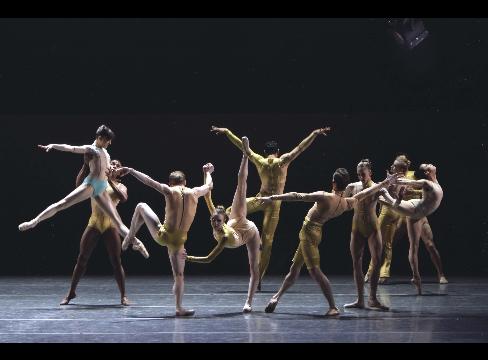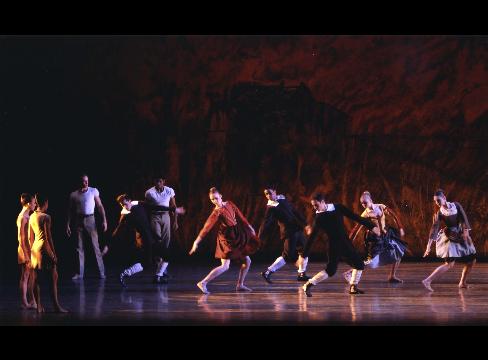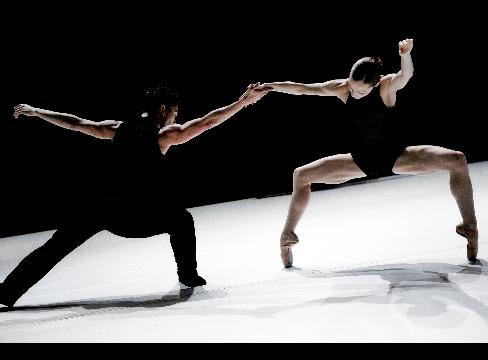This article originally appeared in the Culture section of Bloomberg News on January 26, 2009.

New York City Ballet dancers take part in a performance of “Lifecasting” in New York in this undated handout photo. Performances continue through March 1 at Lincoln Center’s David H. Koch Theater. Photographer: Paul Kolnik/NYCB via Bloomberg News
Jan. 26 (Bloomberg) — For George Balanchine’s birthday last Thursday at Lincoln Center’s David H. Koch Theater, the New York City Ballet premiered Douglas Lee’s “Lifecasting,” a dark yet strangely emotionless fantasy.
It was part of the company’s annual New Combinations evening, intended as a tribute to the master, who died in 1983. The tone of the piece is grave; the choreography, weightily somber. Yet it made me think, irreverently, of a child’s dream about classical statues in a museum coming to life when no one’s looking.
“There are no new steps, only new combinations,” Balanchine once declared. Peter Martins borrowed from this when he initiated the project, which has turned out to be a mixed blessing as gifts go. Usually it results in ballets less than wonderful, by choreographers trying too hard to look like the latest on the cutting edge.
One expects more persuasive results from Lee. Born in England, he trained at the Royal Ballet School, is now a principal dancer with the Stuttgart Ballet, and has participated in City Ballet’s New York Choreographic Institute. Yet, as we see time and again, pedigree alone doesn’t do the trick.
Set to music by Ryoji Ikeda and Steve Reich (not so odd a couple as you might think), “Life Casting” takes its title from the sculptor’s process of making casts directly from the human body. We see a bevy of dancers in a generically stark, handsome set, clad by Ines Alda in pale leotards suggesting plaster. Dancers are routinely considered a life force, but these are often eerily still or at least rooted to one spot, one of them always lying supine, as if laid out in death.
No Human Emotion
Matters eventually get somewhat livelier — bodies group themselves variously, small ones form to manipulate a single pliant figure — yet obdurately refuse to project any human feeling or purpose.
I enjoyed the movement Lee contrived, encompassing both the sinuous and the angular, but I remain baffled by what the choreographer expected his audience to make of it. The standouts in the cast were Robert Fairchild, Kaitlyn Gilliland and
Maria Kowroski.
This year’s New Combinations is subtitled “A Tribute to Nureyev,” in recognition of the Rudolf Nureyev Dance Foundation, which initiated a program of ongoing support for so-called emerging choreographers to work with the company. Unfortunately one of this year’s planned new works, by the Russian Alexey Miroshnichenko, had to be postponed until 2010.

New York City Ballet dancers take part in a performance of “La Stravaganza” in New York in this undated handout photo. Performances continue through March 1 at Lincoln Center’s David H. Koch Theater. Photographer: Paul Kolnik/NYCB via Bloomberg News
The program was fleshed out with the pas de deux from August Bournonville’s charmingly flirtatious “The Flower Festival at Genzano,” Angelin Preljocaj’s incomprehensible “La Stravaganza,” the poignant pas de deux from Christopher Wheeldon’s “After the Rain,” and Balanchine’s “Theme and Variations,” evoking the brilliant grandeur of the Maryinsky tradition in its heyday.
Wouldn’t you know that, of these, the oldest, “Flower Festival” (1858) and “Theme” (1947), boasted the best choreography. You can usually, though not always, trust generations of viewers to know what’s worthy of an ongoing life.
The balletomanes in the audience succumb to Bournonville’s intricate steps; the rest of the crowd, to the charm the piece exudes. And surely everyone watching “Theme” these days can use a dose of palatial elegance.
Through March 1 at Lincoln Center, Broadway at 65th St. Information: +1-212-721-6500; http://www.nycballet.org.
© 2009 Bloomberg L.P. All rights reserved. Reprinted with permission.




